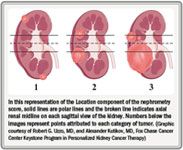Article
Novel system standardizes assessment of renal masses
Author(s):
A standardized scoring system for grading the anatomy of renal masses enables meaningful comparisons of outcomes and provides a clinical tool for guiding tumor management decisions.
Chicago-A novel scoring system quantifying the salient anatomy of renal masses may ensure more standardized characterization of renal tumors to enable meaningful comparisons of outcomes reported in the urologic literature and to provide a useful clinical tool for guiding management decisions, according to urologists at Fox Chase Cancer Center, Philadelphia.

The system is named R.E.N.A.L.–NS, an acronym derived using the first letter of each of the five anatomic features incorporated in the nephrometry score (NS).

Replicable results
Detailed information about the scoring system, a nephrometry calculator, and examples of applications are accessible online at http://www.nephrometry.com/. The five anatomic features it assesses relate to tumor respectability and include Radius (as measured by maximal diameter), Exophytic/endophytic properties (at the deepest location), Nearness of the deepest portion to the collecting system or sinus, Anterior or posterior descriptor, and Location relative to the "polar line" (ie, the portion of the kidney where the concentric rim of the renal parenchyma is interrupted by the renal hilar vessels, pelvis, or fat on axial imaging). The R, E, N, and L components are scored on a scale of 1 to 3 and the "a" or "p" (indicating whether the tumor is anterior or posterior) follows as a suffix. An additional suffix, "h", is used to designate hilar tumors, defined as masses in contact with a main renal artery or vein.
The total possible score ranges from 4 to 12; scores of 4–6, 7–9, and 10–12 represent low-, moderate-, and high-complexity lesions, respectively. However, the developers of the system envision that recording the data analogous to a Gleason score, with each component identified separately, communicates the most information regarding the mass.
In an initial retrospective investigation, the scoring system was applied to quantify 50 consecutive renal masses treated at Fox Chase by various surgical approaches. The results supported its utility, as tumors with a total score of 4–6 or 7–9 were found to be more often resected by partial nephrectomy using primarily minimally invasive approaches, while high-complexity lesions with a score of 10–12 were more likely to undergo open partial nephrectomy or laparoscopic radical nephrectomy.
"We are currently conducting prospective studies at our and other institutions to validate this system," Dr. Kutikov said.
Newsletter
Stay current with the latest urology news and practice-changing insights — sign up now for the essential updates every urologist needs.















